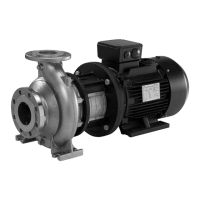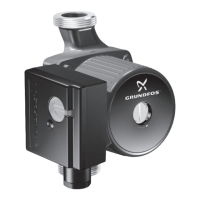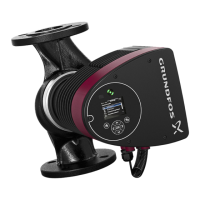English (GB)
20
8.7 Vibration dampening
8.7.1 Elimination of noise and vibrations
In order to achieve optimum operation and minimum
noise and vibration, consider vibration dampening of
the pump. Generally, always consider this for pumps
with motors of 11 kW and up. For motors of 90 kW
and up vibration dampening should be considered
mandatory. Smaller motor sizes, however, may also
cause undesirable noise and vibration.
Noise and vibration are generated by the revolutions
of the motor and pump and by the flow in pipes and
fittings. The effect on the environment is subjective
and depends on correct installation and the state of
the rest of the system.
Elimination of noise and vibrations is best achieved
by means of a concrete foundation, vibration
dampers and expansion joints. See fig. 18.
8.7.2 Vibration dampers
To prevent the transmission of vibrations to
buildings, we recommend isolating the pump
foundation from building parts by means of vibration
dampers.
The selection of the right vibration damper requires
the following data:
• forces transmitted through the damper
• motor speed, taking speed control, if any, into
consideration
• required dampening in % (suggested value is 70
%).
The selection of vibration damper differs from
installation to installation. In certain cases, a wrong
damper may increase the vibration level. Vibration
dampers should therefore be sized by the supplier of
the vibration dampers.
If you install the pump on a foundation with vibration
dampers, always fit expansion joints on the pump
flanges. This is important to prevent the pump from
"hanging" in the flanges.
8.8 Expansion joints
Expansion joints provide these advantages:
• absorption of thermal expansion and contraction
of pipework caused by variations in liquid
temperature
• reduction of mechanical influences in connection
with pressure surges in the pipework
• isolation of structure-borne noise in the pipework
(only rubber bellows expansion joints).
The expansion joints should be fitted at a minimum
distance of 1 to 1 1/2 pipe diameters (DN) away from
the pump on the suction and the discharge side. This
prevents turbulence in the joints, thus ensuring
optimum suction conditions and minimum pressure
loss on the discharge side. At flow velocities > 5 m/s,
we recommend fitting larger expansion joints
matching the pipework.
Figures 20 and 21 show examples of rubber bellows
expansion joints with or without limiting rods.
Fig. 20 Rubber bellows expansion joint with
limiting rods
Do not install expansion joints to make up
for inaccuracies in the pipework, such as
centre displacement or misalignment of
flanges.
TM02 4979 1902

